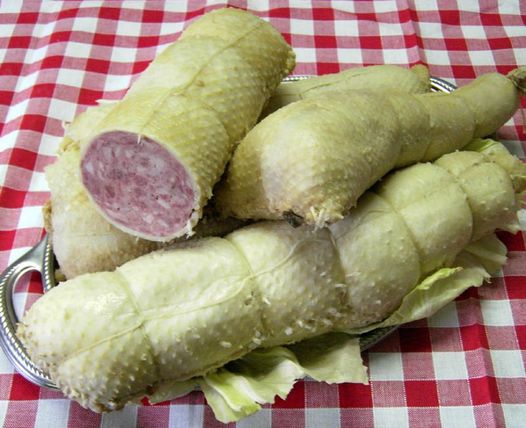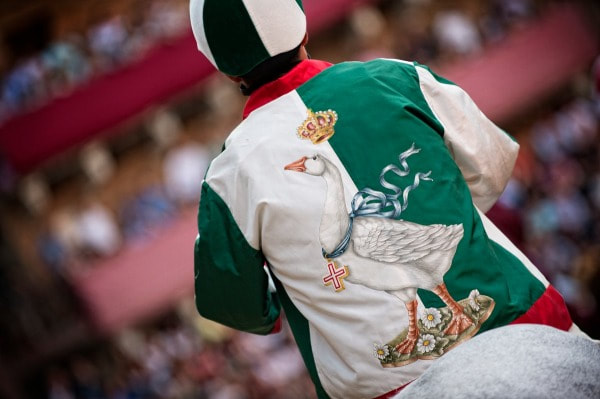 Boy wrestling a goose Boy wrestling a goose Domestication of geese dates back to Neolithic times, about 6,000 years ago. During the Roman Empire there is much evidence of breeding geese in both writings and art. Of course, the ancient Romans saw the goose as a ready source of food high in protein and fats. L'oca (the goose) was written about in the 1st century collection of recipes by Marco Gavio Apicius, the most famous of Roman culinary maestros. The goose was fattened with dried figs and wine mixed with honey, then were either oven roasted, spit-roasted or boiled and served with a sauce made with pepper, coriander, mint, rue and olive oil. Its liver was a delicacy to be dipped in milk and honey. It's also obvious to historians that Charlemagne, the Emperor of the Holy Roman Empire also favored the development the valuable goose. In the Middle Ages he personally owned 30 geese on his farm for domestic use and trade. In Italy as well as other countries, goose is the preferred celebratory food on the day of San Martino. Aside from food, the goose served many other purposes. In the 15th century, Paolo Santonino wrote in his Itinerarium Sanctonini, "Wherever there is an abundance of geese, even the poorest peasants have a feather bed". With their exceptional eyesight, wide field of vision, extremely loud and boisterous honking, a gaggle of geese makes excellent guards to warn of poachers, intruders, thieves and predators, and unlike dogs, they can't be silenced by offering them a treat.  Protecting the brew as it ages Protecting the brew as it ages In 390 BC, when Rome was attacked by Gallic troops, their honking alarmed when an enemy attempted an attack. Even today, geese are used in Italy, not only to eat pests in vineyards and olive and nut groves (a very organic approach to avoid pesticides), but they will warn the owner of poachers entering their lands. They have also been used to protect wine and whisky cellars. Old school Italians even forecast the weather using the goose... at the dinner table, that is. If the bones are white, the winter will be short and mild; if they are dark is a sign of rain, snow and cold. Gaming the Goose  The goose has also given its share of fun to early households in the form of the game called Gioco dell'Oco. Even saying the name is fun... Jy-Oko, dell Oko. In the Game of the Goose the object is fairly straightforward, rolling the dice and being the first to make it to the center. There are obstacles to avoid, just like in the child's game Candy Land, except rather than getting stuck on a Licorice Stick, the obstacles are the Inn, the Bridge and Death. The game originated sometime in the 16th century, and is considered the forefather of most board racing games. Manufactured versions appeared in the late 19th century, and modern versions are still played throughout Italy and Europe. There are even life-sized games with real geese played during the Festival of San Marino in some towns like Mirano and Mortara.  Mirano festival Mirano festival In Italy, goose-based lunches are typical northern regions such as Friuli, Veneto, Lombardy and Romagna. In several places the Dinner of San Martino is an entire menu based on goose. In the province of Pavia the town of Mortara has the nickname City of the Goose where one specialty is goose salami, called Salumi dell'Oca. Having a strong Jewish heritage, this high fat sausage replaces typical pork sausage on the table and is prepared in the Kosher tradition. In addition to their fatty meat, geese produce large edible eggs, weighing up to 6 ounces each. They are used just as chicken eggs are, but have a much larger yolk with a more gamey flavor. As part of the Cucina Povera in past history, a goose egg would have been preferred over a chicken egg since each egg contains much more fat and calories (essential to get through a lean growing season or winter). Perhaps this is where the idea of the Goose Who Laid a Golden Egg came from. Here's a comparison between chicken and goose eggs: Chicken - 1.5 oz; 72 calories; 4.75 grams total fat/1.56 grams saturated;6 grams protein Goose - 6 oz; 266 calories; 19.11 grams total fat/5.1 grams saturated; 20 grams protein In a modern healthy diet, one rarely considers eating goose eggs, especially if trying to lower their dietary cholesterol... One large chicken egg contains 186 mg of cholesterol, but a single goose egg contains 1,227 mg of cholesterol! So you see, the contadini (farmers) of Old Italy considered raising geese as a sound investment. They are a good source of high fat, high calorie, high protein food; a "watchdog" against intruders; down for his beds, and for the most part, geese get their own food, grazing for garden pests and are happy to eat kitchen scraps. Keeping geese around was very furbo.  Prosciutto dell'Oca locked in its stand ready for thin slicing Prosciutto dell'Oca locked in its stand ready for thin slicing In northern Italy, where there is a large Jewish culture, there is an artisan process of creating Prosciutto dell'Oca (goose ham). This is a lean product, similar to prosciutto, made using the leg of the goose, seasoned with salt, pepper and spices and aged for about 2 months or more. Its color is dark red, with a sweet taste and an intense aroma. It is used as an appetizer for important occasions and often served on bruschetta with a glass of local wine. The city of Mortara, offers Prosciutto dell'Oca during both spring and fall festivals. Siena and its Winning Contrada dell'Oca  In Italy, cities are divided into contrade (districts or wards), with the most famous being the 17 contrade of Siena whose representatives race on horseback in the Palio di Siena, run twice each year. Each contrada has an animal as its mascot, produly and loveingly displayed on flags all over the city. The one that we point out here is the Contrada dell'Oca. If you love geese, than this is the flag you should be rooting for when you visit Siena to witness this exciting horse race. But there's another reason... The Noble Contrada dell’Oca holds the record of winning 65 Palios races, from its inception in 1644 to the present day.
Viva l'oca! --Jerry Finzi |
On Amazon:
|




























 RSS Feed
RSS Feed
